Lecture 13: Combinatorics
- Combinatorics in Computer Science
- Counting Principles
- Basic Counting Rules: Union
- Basic Counting Rules: Product
- Combinatorial Symmetry
- Combinations and Permutations
- Alternative Techniques
- Difficult Counting Problems (not assessed)
Combinatorics in Computer Science
Informally, combinatorics is the mathematics of counting.
More formally, combinatorics is about understanding finite systems of discrete objects.
For example:
- How many different ways are there of getting a flush in poker?
In computer science, we use combinatorics when:
- Computing cost functions in algorithmic analysis
- Identifying (in-)efficiencies in data management
- Developing effective techniques for enumerating objects
- Probability calculations
Counting Principles
General idea: find methods, algorithms or precise formulae to count the number of elements in various sets or collections derived, in a structured way, from some basic sets.
Examples
Single base set
, and $∣S∣ = n$; find the number of
- all subsets of S
- ordered selections of r different elements of S
- unordered selections of r different elements of S
- selections of r elements from S such that …
- functions $S ⟶ S (onto, 1-1)$
- partitions of S into k equivalence classes
| Starter | Main Course | Dessert |
|---|---|---|
| Soup | Fish | Ice-cream |
| Bread | Beef | Fruit |
| Pork | Cheese | |
| Chicken |
How many:
- 3 course meals (Starter-Main-Dessert) are possible?
- 3 course meals (Any item for each course) are possible?
- 3 course meals (Any item, no duplicates) are possible?
- Meals consisting of 3 items (order is unimportant)?
These problems are translated into these below:
How many:
- Starter-Main-Dessert?
- Any item for 3 courses?
- Any item, no duplicates, for 3 courses?
- Meals of 3 different items?
Note, why $504/6 = 84$? Because (order is unimportant), and the order of 3 items is $3!=6$. 504 is the number of 3 ordered items, and 84 is the number of 3 unordered items.
How to understand the number of 3 ordered items is $3!=3 \times 2 \times 1=6$? We could think it’s $3 \times 2 \times 1$ of each time we choose the left items, and it’s exactly the factorial!
Basic Counting Rules: Principles
Two simple rules:
- Union rule (“or”): If $S$ and $T$ are disjoint $∣S ∪T∣ =∣S∣+∣T∣$
- Product rule (“followed by”): $∣S × T∣ = ∣S∣ ⋅ ∣T∣$
These cover many examples, though the rule application is not always obvious.
Common strategies:
- Direct application of the rule
- Relate unknown quantities to known quantities (e.g. $∣S∣ +∣T∣ = ∣S ∪T∣+∣S ∩T∣$)
- Find a bijection to a set that can be counted
Basic Counting Rules: Union
Union rule — S and T disjoint
$S_1,S_2,…,S_n$ pairwise disjoint ($S_i ∩ S_j = ∅ \quad for \quad i ≠ j$)
Example
How many numbers in $A = [1,2,…,999]$ are divisible by 31 or 41?
A:
Consequences of the Union Rule
Fact
For any sets X, Y, Z:
Fact
(1) If $∣S ∪T∣ = ∣S∣+∣T∣$ then $S$ and $T$ are disjoint
(2) If $∣⋃^n{i=1} S_i∣ = ∑^n{i=1} ∣S_i∣$ then $S_i$ are pairwise disjoint
(3) If $∣T \setminus S∣ = ∣T∣−∣S∣$ then $S ⊆ T$
These properties can serve to identify cases when sets are disjoint
(resp. one is contained in the other).
Proof
We can prove these facts using the inclusion-exclusion identity for two sets. Namely, that $∣S ∩ T∣ +∣S ∪T∣ = ∣S∣+∣T∣$.
(1) Suppose ∣S∣ +∣T∣ = ∣S ∪T∣. Then inclusion-exclusion gives $∣S ∩T∣ =∣S∣+∣T∣−∣S ∪T∣ =0, so S ∩T =∅$.
(3) Suppose $∣T \setminus S∣ = ∣T∣−∣S∣$. Then inclusion-exclusion gives $∣S ∩T∣ =∣S∣$, so $S ⊆ T$.
Exercises
Q: 200 people. 150 swim or jog, 85 swim and 60 do both. How many jog?
A:
Let S ∶= {people who swim} and J ∶= {people who jog}.
Then $∣S ∪J∣ = ∣S∣+∣J∣−∣S ∩J∣$; thus $150 = 85+∣J∣−60$, hence $∣J∣ = 125$.
Note that the answer does not depend on the number of people overall (200).
Q: (Supp)There are 100 problems, 75 of which are ‘easy’ and 40 ‘important’. What’s the smallest possible number of problems that are both easy and important?.
A:
Basic Counting Rules: Product
The Product Rule
Product rule:
Take Notice
This counts the number of sequences where the first item is from $S_1$, the second is from $S_2$, and so on.
Sequences mean that it’s an ordered pair.
Special case of the product rule: If all $S_i = S$ for all i and $∣S∣ = m$ then
Example
Let Σ = {a,b,c,d,e,f,g}.
Question. How many 5-letter words can we make?
Question. How many words with no letter repeated?
Or firstly choose 5 letters from the 7 letters, and this is a combination. Then arrange the 5 chosen letters.
Or permutation number:
Product rule: Sequences of selections
Question: How can we count sequences when the underlying set changes?
A:
To count sequences without replacement:
Define an order on the whole underlying set
Select from $[1,n]$, where n is the size of the “remaining” set, and a selection of i represents choosing the i-th element in that set
Example
Let Σ = {a,b,c,d,e,f,g}.
How many 5-letter words with no letter repeated?
Exercises 1
S,T finite. How many functions $S ⟶ T$ are there?
For all in S has the element in T. So it’s $|T| \times |T| \times … |T| \quad \therefore ∣T∣^{∣S∣}$
Exercises 2
Q:
$S=[100…999]$, thus $∣S∣=900$.
(a) How many numbers in S contain a 3 or 7 in their digits?
(b) How many numbers in S have a 3 and a 7?
A:
(a) How many numbers in S contain a 3 or 7
Let $A_3$ = {at least one ‘3’} and $A_7$ = {at least one ‘7’}. Then
Note that for each number in S, there are 7 choices for the first digit and 8 choices for the later digits. So
Therefore $∣A_3 ∪ A_7∣ = ∣S∣ −∣(A_3 ∪A_7)^c∣ = 900−448 = 452$.
(b) How many numbers in S have a 3 and a 7?
Combinatorial Symmetry
A symmetry of a mathematical object is a bijective mapping from the object to itself which preserves “structure”.
A (combinatorial) symmetry defines an equivalence relation where the equivalence classes all have the same size.
We are often interested in counting a set “up to symmetry”. That is, counting the number of equivalence classes.
This can also be stated as a constraint that identifies a specific item in each equivalence class (symmetric constraint).
Definition
A k-to-1 function is a function that maps exactly k inputs to an output.
Take Notice
A k-to-1 function defines the equivalence relation of a combinatorial symmetry and vice-versa.
Product rule: Symmetries and duplications
Question
- How can we count sequences when we have symmetric
constraints? - How can we count sequences when we have duplicates?
Example
Let Σ = {a,b,c,d,e}.
- How many 5-letter words with no letter repeated and a before b before c?
- How many 5-letter words can be made from a,a,a,d,e?
Take Notice
The answer will be the same.
Jiaojiao’s solution:
and for the second question, we just consider the d and e, and it’s equivalent to the first question.
My stupid and slow solution:
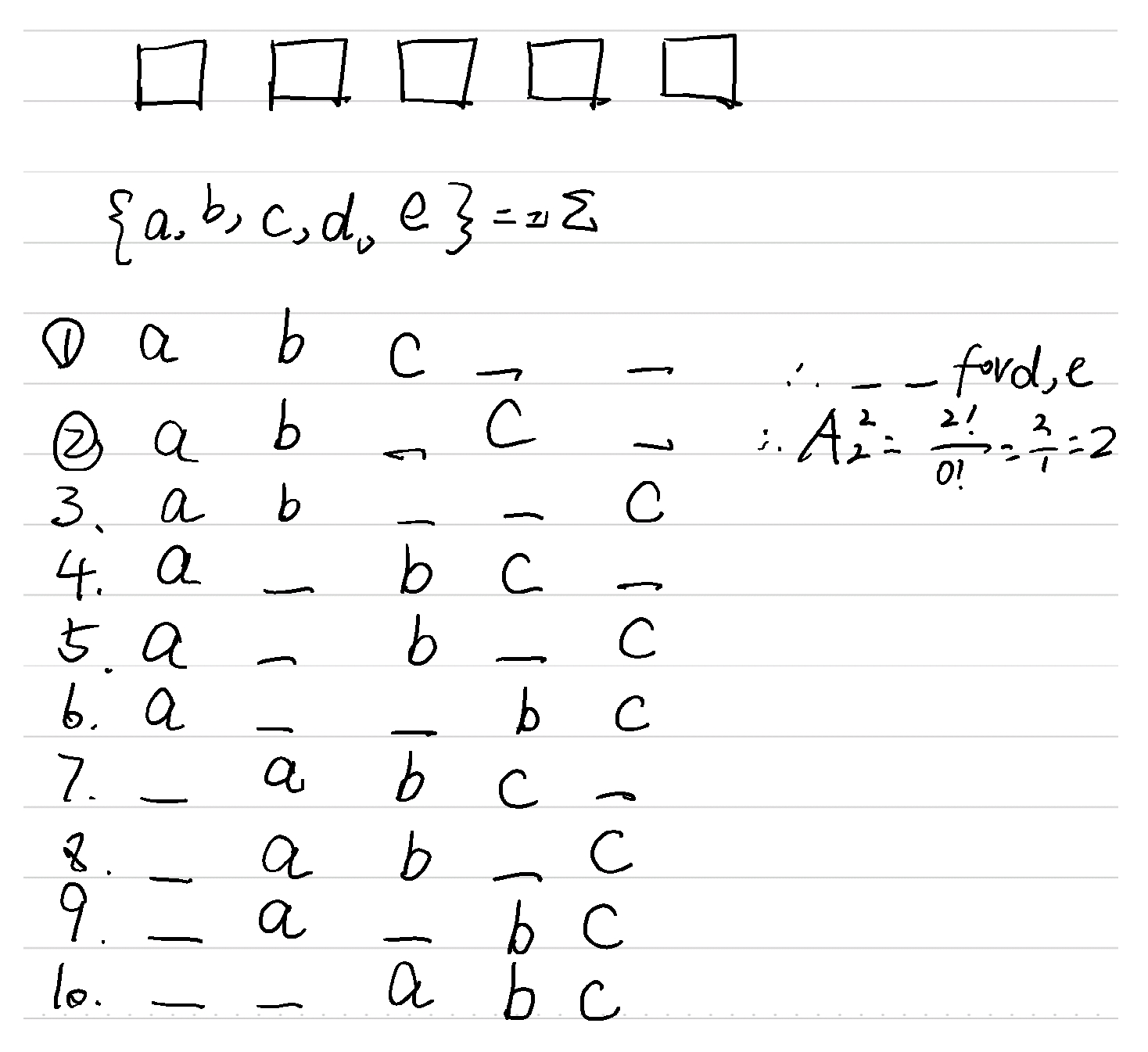
Hence 2*10 = 20
Product rule: Symmetries and duplications
so
Alternatively, $\frac{1}{∣S_2∣}$ of the $∣S∣$ sequences meet the symmetric constraint.
Example
Question. Let Σ = {a,b,c,d,e}. How many 5-letter words with no letter repeated and a before b before c?
Answer
Let Σ′ = {a,b,c}. Then
and
So
Combinations and Permutations
Combinatorial Objects: How Many?
permutations
Ordering of all objects from a set S; equivalently: Selecting all objects while recognising the order of selection.
The number of permutations of n elements is
r-permutations (sequences without repetition)
Selecting any r objects from a set S of size n without repetition while recognising the order of selection.
Their number is
Permutations with duplicates
Example 1
Q: How many anagrams of ASSESS? Namely $\Sigma$={A,S,S,E,S,S}, and what is the number to permutate them?
A:
Label S’s: $AS_1S_2ES_3S_4: 6!$
In each anagram we can label the S’s in 4! ways.
Suppose there are m anagrams. So $m ⋅4!=6!$, i.e. $m=\frac{6!}{4!}$
Example 2
Number of anagrams of MISSISSIPPI?
r-selections (or: r-combinations)
Collecting any r distinct objects without repetition; equivalently: selecting r objects from a set S of size n and not recognising the order of selection.
Take Notice
These numbers are usually called binomial coefficients due to
Also defined for any $\alpha \in \mathbb{R}$ as $\binom{\alpha}{r}=\frac{\alpha(\alpha-1)…(\alpha-r+1)}{r!}$
Simple Counting Problems
Give an example of acounting problem whose answer is
(a) $(26)_{10}$
(b) $\binom{26}{10}$
Draw 10 cards from a half deck (eg. black cards only)
(a) the cards are recorded in the order of appearance
(b) only the complete draw is recorded
Examples
Number of diagonals in a convex polygon
Number of poker hands
Decisions in games, lotteries etc.
Exercises: choose to from committees
From a group of 12 men and 16 women, how many committees can be chosen consisting of
(a) 7 members?
$\binom{12+16}{7}$
(b) 3 men and 4 women?
$\binom{12}{3}\binom{16}{4}$
(c) 7 women or 7 men?
$\binom{12}{7} + \binom{16}{7}$
As above,but any 4 people (male or female) out of 9 and two, Alice and Bob, unwilling to serve on the same committee.
Method 1:
Firstly, choose 4 people from 9 people. Secondly, consider Alice and Bob are in one committee, so 7 people remained, choose 2 more people from these 7 people, and could form a committee with Alice and Bob.
Method 2:
equivalently, {A in, B out} + {A out, B in} + {none in} = $\binom{7}{3}+\binom{7}{3}+\binom{7}{4}$ = 35 +35+35 = 105
Exercises:Counting Poker Hands
A poker hand consists of 5 cards drawn without replacement from a standard deck of 52 cards
{A,2-10,J,Q,K} ×{club ♣,spade ♠,heart ♥,diamond ♦}
(a) Number of “4 of a kind” hands (e.g. 4 Jacks)
∣rank of the 4-of-a-kind∣ ⋅ ∣any other card∣ = 13 ⋅ (52 − 4)
这里问的是几种组合,所以13是A->K的同点数之一,然后因为一手5个牌还差一个,因此从(52-4)中随便选一个牌。
(b) Number of non-straight flushes, i.e. all ards of same suit but not consecutive (e.g. 8,9,10,J,K)
∣all flush∣ − ∣straight flush∣ = ∣suit∣⋅∣5-hand in a given suit∣ − ∣suit∣ ⋅ ∣rank of a straight flush in a given suit∣ = $4 \cdot \binom{13}{5} - 4 \cdot 10$
在问非顺子但同花的组合,4个花色乘13(同花)中抽5张(同花牌的数量),减去顺子同花:这种情况有10种可能的顺子(从 A, 2, 3, 4, 5 到 10, J, Q, K, A),因此顺子同花是$4 \cdot 10$. 故最终结果是以上两项相减。
注意,A在“A2345”和“10 JQKA”都可以是同花顺,所以同花情况下,应该是10个情况而不是9个情况。

Summary
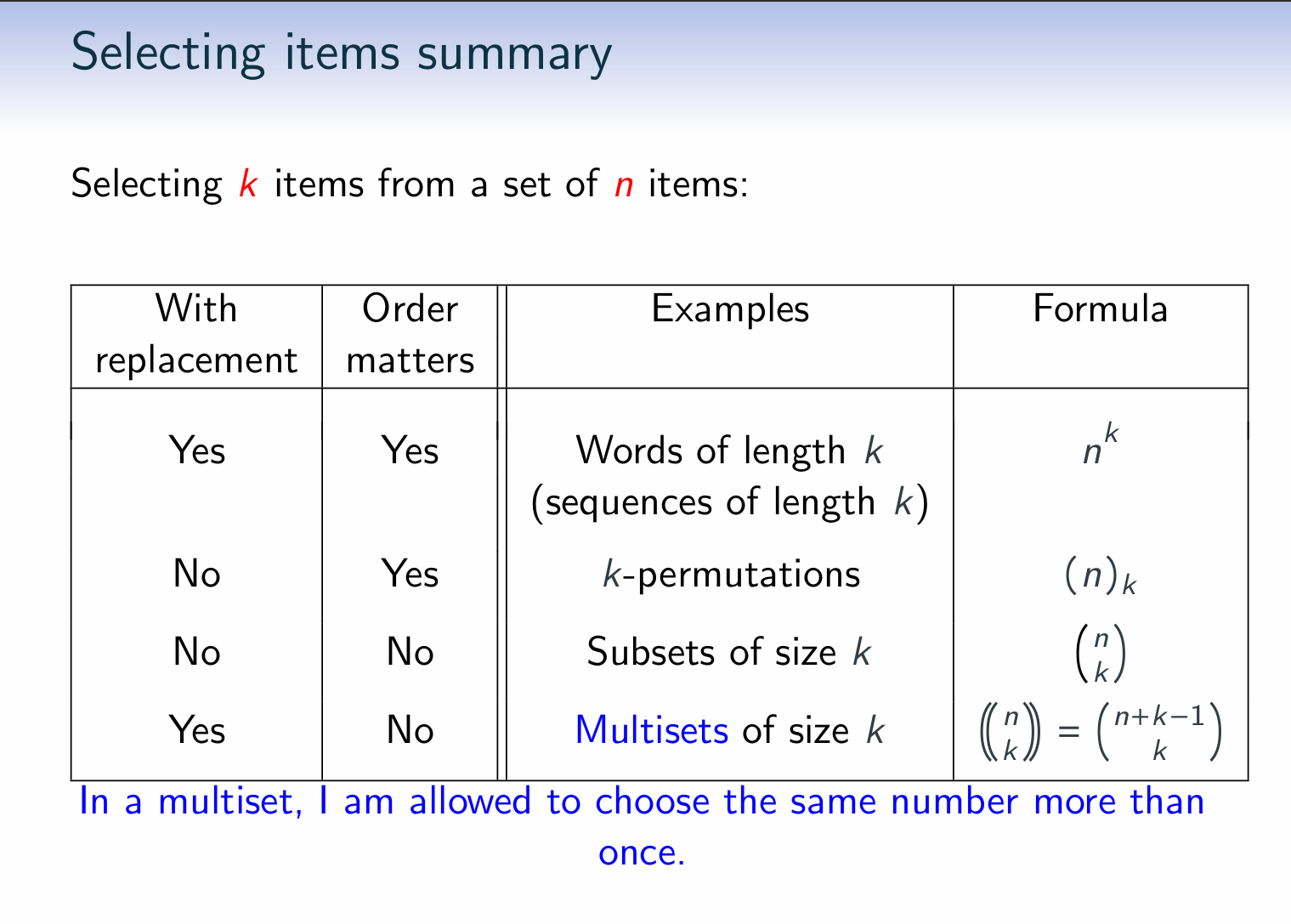
“Balls in boxes”
Have n “distinguishable” boxes.
Have k balls which are either:
- Indistinguishable
- Distinguishable
How many ways to place balls in boxes with
- At most one
- Any number of
balls per box
Take Notice
Suppose K is a set with $∣K∣ = k$ and N is a set with $∣N∣ = n$:
- 2A counts the number of injective functions from K to N
- 2B counts the number of functions from K to N
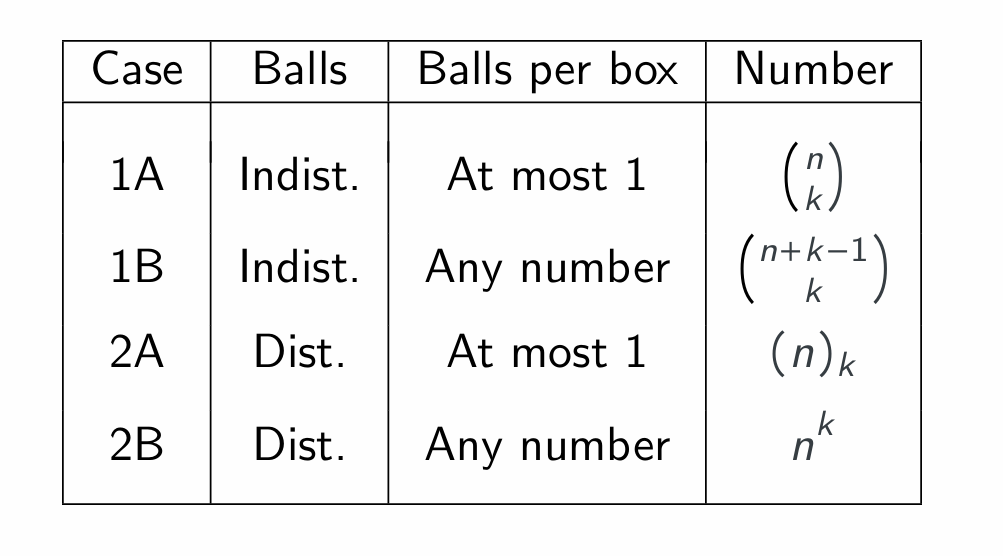
Alternative Techniques
What if the current techniques are unwieldy?
Other techniques for obtaining an exact count:
- Find a different approach for counting
- Make use of symmetries
- Make use of recursion
- Write a program (running time?)
Example
How many sequences of 15 coin flips have an even number of heads?


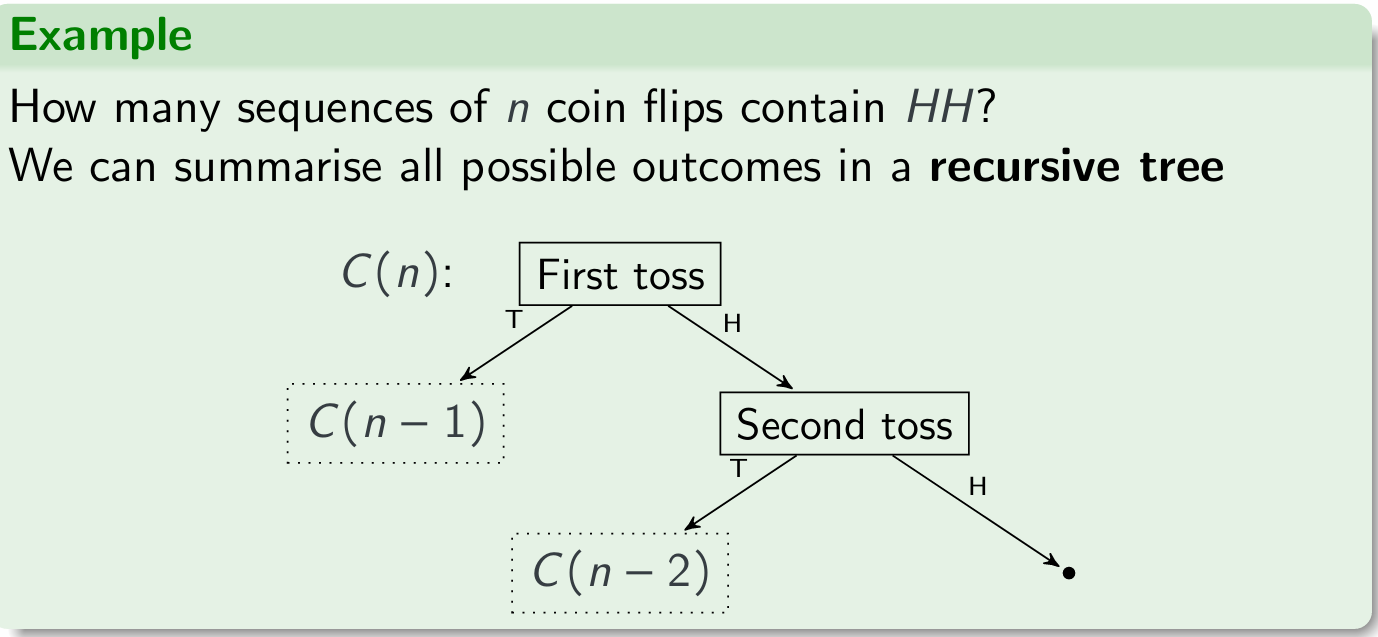

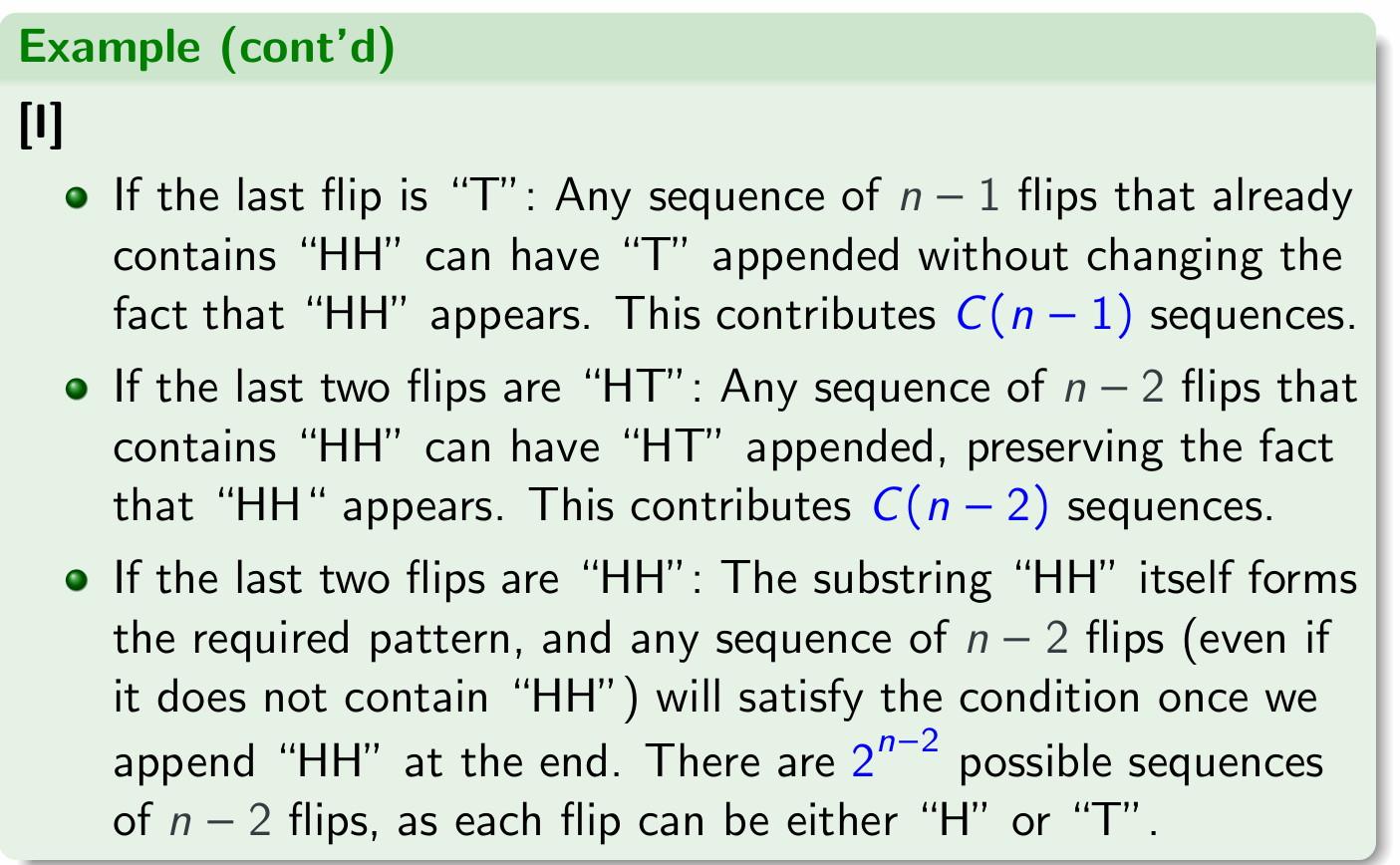
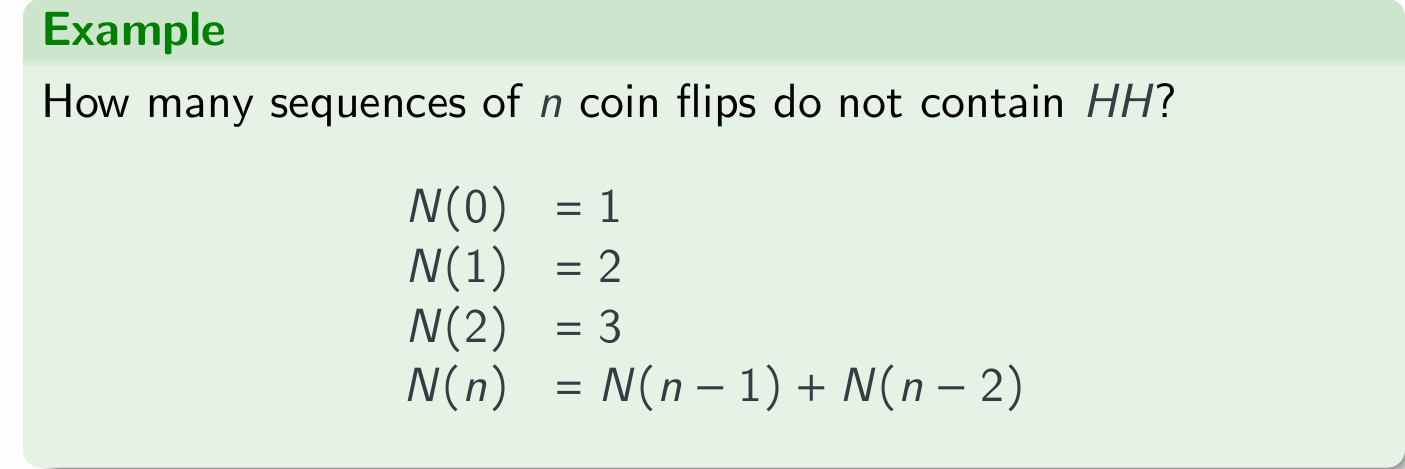
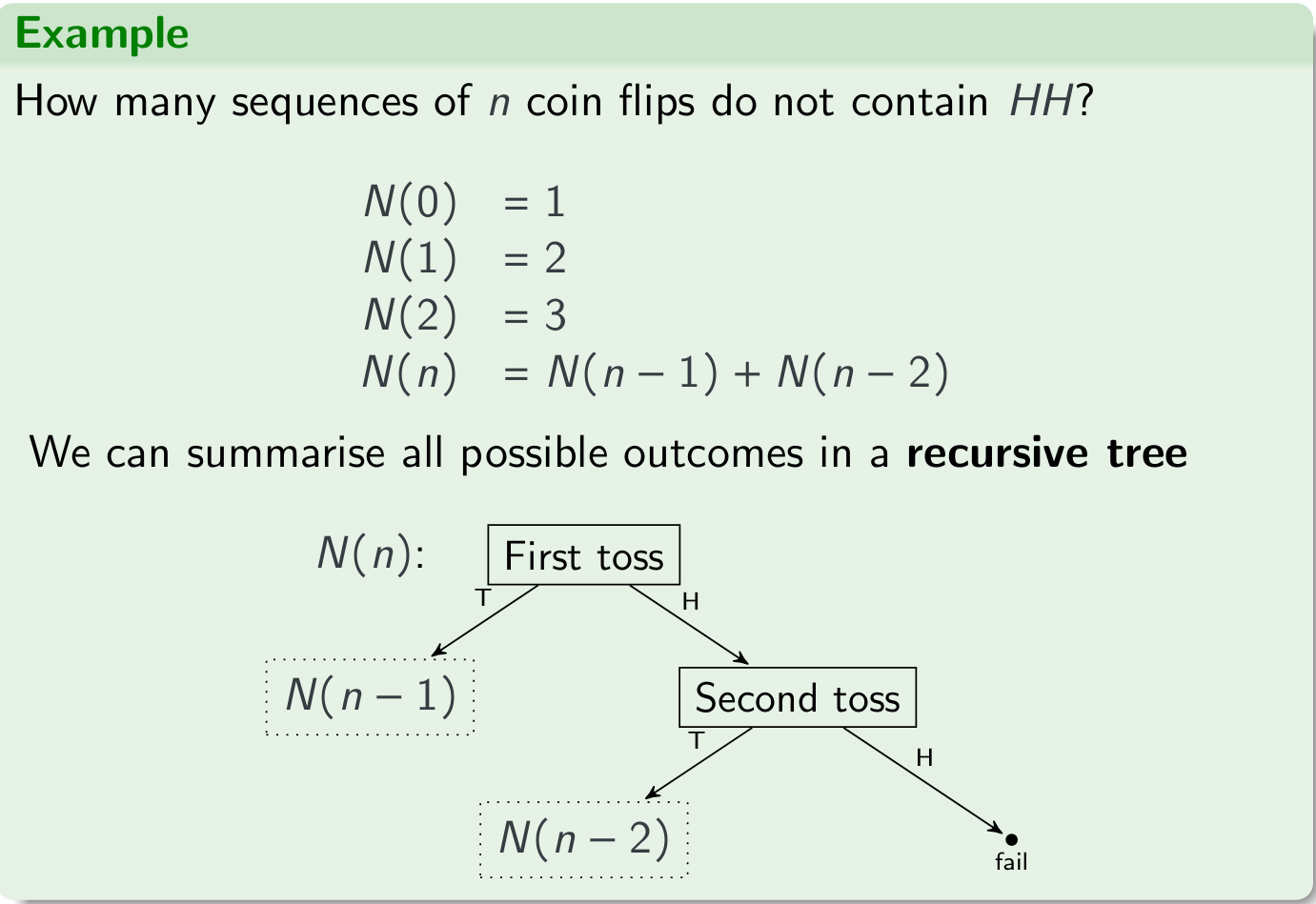

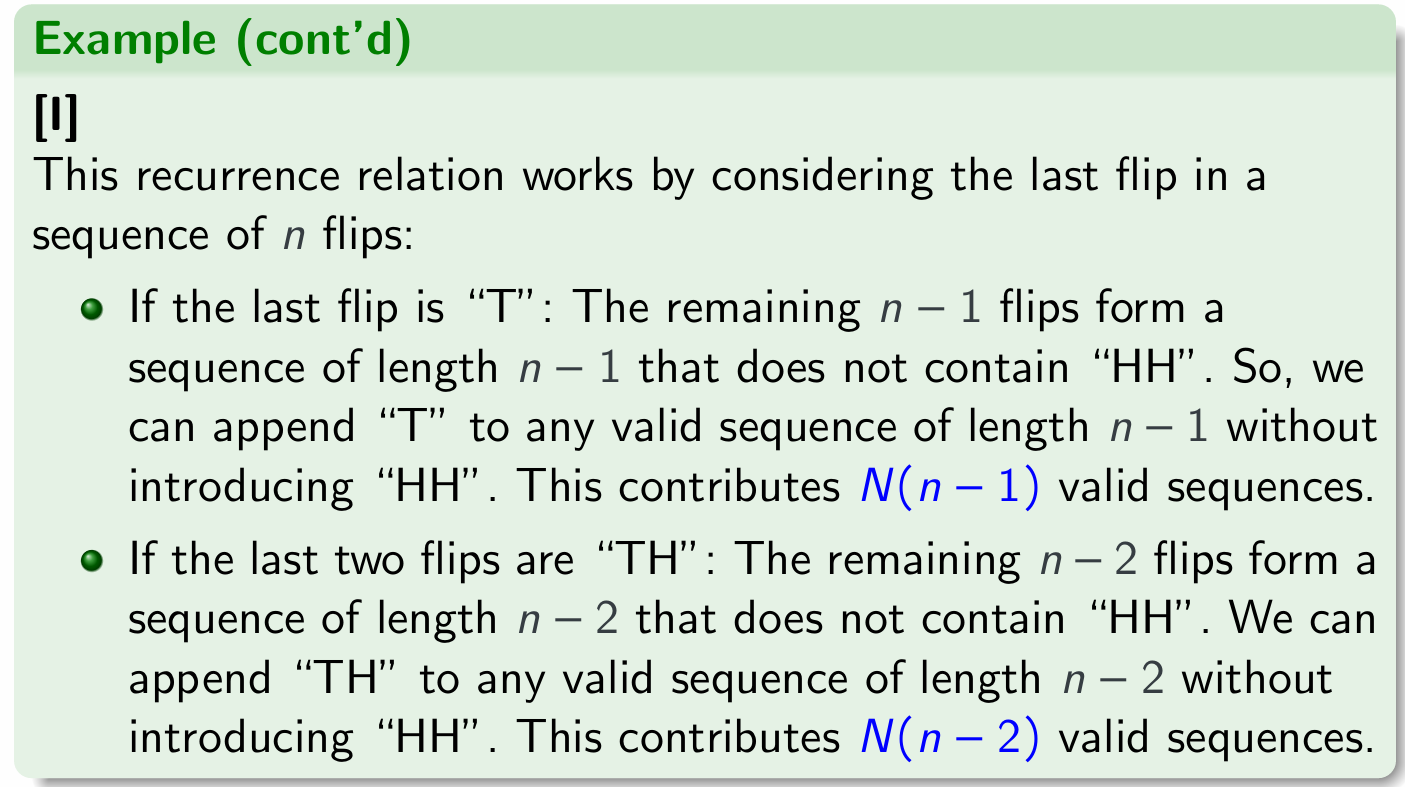
Difficult Counting Problems (not assessed)
Using Programs to Count
Two dice, a red die and a black die, are rolled.
(Note: one die, two or more dice)
Write a program to list all the pairs {(R,B) ∶ R > B}
Similarly, for three dice, list all triples R > B > G
Generally, for n dice, all of which are m-sided (n ≤ m), list all decreasing n-tuples
Take Notice
In order to just find the number of such n-tuples, it is not
necessary to list them all. One can write a recurrence relation for
these numbers and compute (or try to solve) it.
Approximate Counting
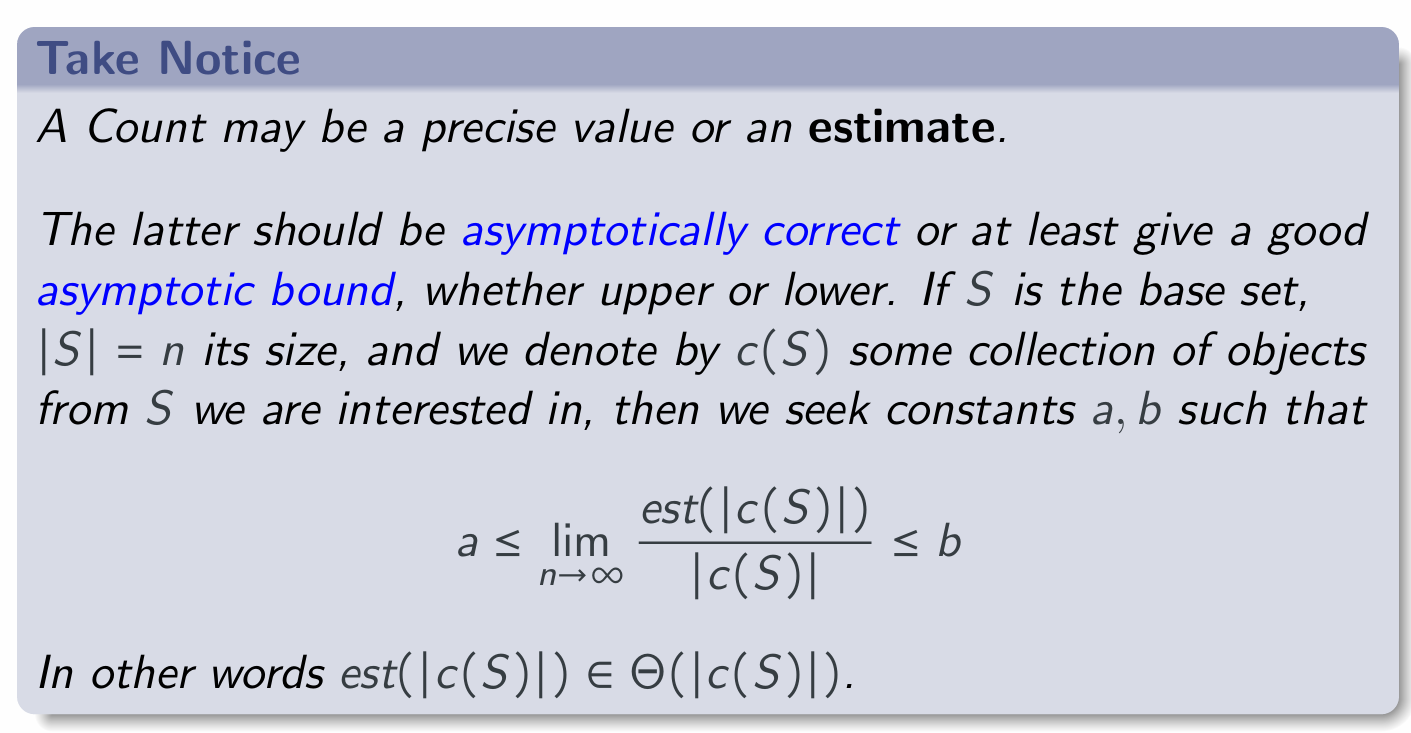
Welcome to point out the mistakes and faults!